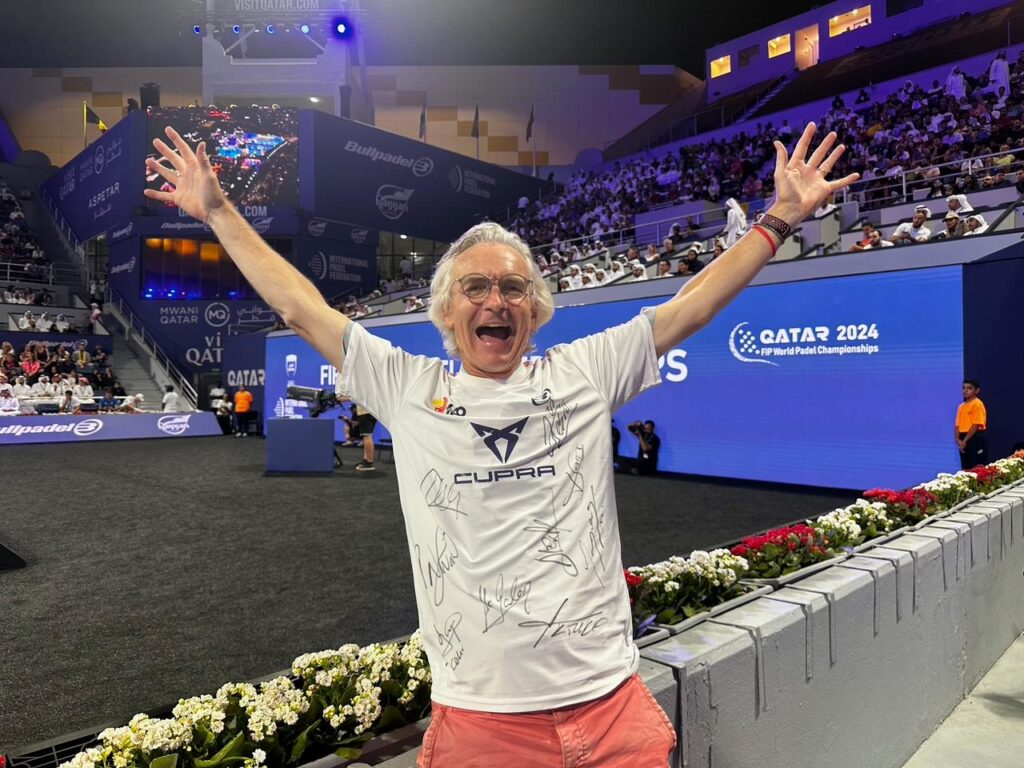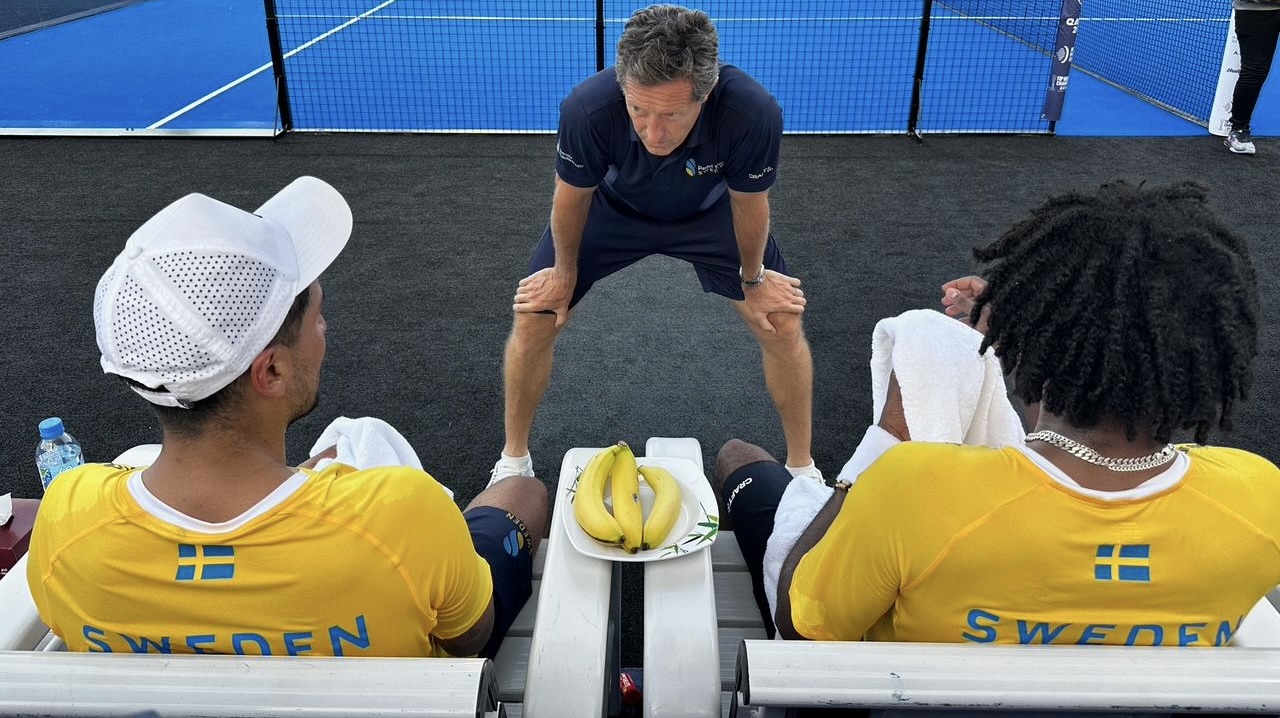Big hitters go head-to-head at World Champs
The Bandeja roving reporter Minter Dial has been on a tour of topflight padel tournaments, with the latest being the recent World Padel Championships in Doha, Qatar. Here Minter reports on match drama and how the script for who reached the finals was etched in stone well before the first ball was served. Spain and Argentina were the only two contenders to be World Champions for both men and women. And, true to form, the finalists were as anticipated. Yet there was plenty of drama and excitement It was, overall, a magnificently inspiring event, including seeing the excitement and competitiveness shared by the lower ranked teams. Minter reports from Qatar.
The championships comprised 16 of the world’s best teams, each comprised of eight players. They were divided into four pools of four teams, with the pool stages taking place over the first three days, featuring best-of-three ties. The first two teams in each pool qualified for the top tier (to determine 1st through 8th) and the bottom two in the lower tier (9th through 16th).

During the pool phase, without doubt, the more interesting matches occurred when two lower ranked countries were vying for the glory of not finishing last. At times, when the matches were played on contiguous courts, the fan noise and umpire calls over the loud-speaker were confusing, if not overwhelming. Some of the more intense matches included, on the women’s side, the encounters between Japan #14 and Uruguay #11 (2-1), and a significant upset where Netherlands #10 overcame the neighbours to the south, Belgium #4 (2-1).
In the men’s draw, the Swedes were ranked 15th without their number one player, Danne Windahl, and they competed well against Brazil (#5), losing 1-2, while beating Netherlands 2-1. Italy, ranked 9th, beat the higher ranked Belgium. Hosts Qatar fielded only a men’s team and managed to win one point against Uruguay. Qatar would go on to win the wooden spoon. However, the most controversial team was the United Arab Emirates (UAE), which fielded a team stacked with four naturalised Spaniards (Inigo Jofre with a FIP world ranking #46, Arnau Ayats #54, Sergio Icardo #137 and Francisco Jurado #280), two of whom are ranked in the top 100 in the world. Ranked 14th at the outset, they lost to Spain but won both their other matches 2-1. The victories were essentially Spanish in nature. The UAE would go on to jump to a 5th place finish, up from 14th at the beginning of the tournament.

When it came to the second half of the week, every match won or lost meant progress upward or downward in the rankings. Every day was drama, unless you were Spain and Argentina, in which case, it was all about figuring out the best pairings for the grand finale.
Per the rankings, there were more surprises among the women and men. The Swedish men’s team did well, overcoming arch-rivals the Netherlands in two 3-set matches to secure 9th place.
Meanwhile on the women’s side, the Netherlands and Denmark both ended up far above their initial rankings. In the end, on the sixth day, each team fought for its final ranking spot.
Taking a helicopter view of the countries, combining men and women, it’s clear that the big winners – perhaps indicative of a better system for growing talent – were Portugal, Italy, and the Netherlands. Certainly, those countries whose men and women’s teams both qualified should also be congratulated. For all the excitement of the other matches, of course, the big denouement lay in the two finals between the perennial padel powerhouses.
Women’s finals
The women’s final heavily favoured Spain against a valiant Argentina
The first pairings involved a straight-forward win by the Spaniards, with the world 3rd and 4th seeds, Gemma Triay and 18-year-old Claudia Fernandez respectively winning in straight sets over Virginia Riera (#16) and Julieta Bidahorria (#37), 6-3 6-2.
The second match, however, was a tantalizing matchup, featuring world number 5, Delfi Brea, alongside the diminutive but super effective left-handed Claudia Jensen (#12), facing off against the world number 1 pairing in the pro tour – leftie Paula Josemaria beside Ari Sanchez. The Argentines came out of the gate sharper and won the first set 6-3. Drama would occur in the see-saw second set with the Spaniards going up a break, only to be broken back twice in a row later in the set. The set would ultimately go to the Spaniards 7-5. In the third set, the Argentines jumped to a lead, breaking in the first game to love, and consolidating the break with a nervy game featuring four deuces. Two games later, the score was tied at 2-2. After another break of the Spaniards’ serve, Brea/Jensen were leading 4-2. At 5-3, the Argentines were two points from victory and at 5-4 secured a match point. However, a simple forehand error by Brea gave the Spaniards a chance to come back and ultimately close out the match at 7-5. Thus, the Spanish team was crowned world champions. There was no need to play the third rubber.
With the Spanish all wearing a black band to mark their solidarity with the tragedy back home in Valencia, they celebrated their sixth championship in a row, bringing their total tally to nine championships versus eight for Argentina.

Men’s final drama
The big finale was, as anticipated, 11-time champions Argentina v five-time champions Spain. On paper the matchup looked to be stacked in Spain’s favour. To wit, the Spaniards conceded just five measly games in the semi-final against Italy, while Argentina were pushed to the limit in a three-setter against the Deus brothers of Portugal, before sweeping to victory in the second rubber. With Argentina having narrowly clinched the last championship in 2022 in the third rubber, Spain was looking for revenge.
Among the curiosities of this match, nearly all of the top-ranked Spaniards (Coello, Galan, Lebron and Yanguas) play with Argentinian partners (respectively, Tapia, Chingotto, Di Nenno and Stupaczuk) in the Premier Padel pro tour. The Spanish national team, selected by coach Juanjo Gutierrez, included two lefties (Jon Sanz and Alex Ruiz) and the right-playing Mike Yanguas as well, the versatile Juan Lebron (the ‘Wolf’). The selection left out a string of other high-ranking players, including Javi Garrido (#10), Momo Gonzalez (#11), and Edu Alonso (#14). As one might say, the breadth of options for Gutierrez was eye-watering.
Likewise, the Argentine team selected by Gabriel Reca, was conspicuously missing several of its top ranked players, including the legend Fernando Belastaguin #16, Juan Tello (#20), Maxi Sanchez (#22), as well as leftie Lucho Capra (#24). Instead, they opted for a team that included the teenager Tino Libaak (#35) and 20-year-old Leo Augsberger (#29).
The first match of the final was a lop-sided affair, with Spaniards Coello and Nieto steam-rolling Di Nenno and Stupa 6-1, 6-2. The second rubber was enticing for a number of reasons, not least of which that Gutierrez chose to put Galan back with Lebron, after their steamy break-up in Doha seven months earlier. Prior to that break-up, the pair had been unstoppable.
The two top-ranked players on the Argentine team, Agustin Tapia ranked #1 in the world and Fede Chingotto (#4) were teamed up for the second match. It would turn out to be a highly charged and tight match. With the first set going to the wire, the Spanish duo found themselves in a tie-break, up 6-4 for two set points in a row. On his service, Galan sent a very basic backhand volley straight into the backwall. The Argentines managed to save the following set point and close out the set, despite being down 0-4 in the breaker. Down a set, the Spaniards managed to corral their energies to win the second set 6-3, but not without a major controversy from the one-and-only Lebron. Cruising at 4-2 and 40-15 in the second set, on a tough shot from Tapia, Lebron appeared to have let a ball in his hand fall to the ground to force a let. FIP is investigating the incident to see if a fine for unsportsmanlike conduct is in order.
The third set was a rock’n’roll affair. The Argentines sprung to a 3-0 lead and failed to convert a further break point for a 4-0 lead. Up 4-2, with Tapia serving, the next game was epic, with six deuces, one video review and finally Argentina going up 5-2. In the following game, on Galan’s service, the Argentines had two match points. The second one was all that was needed for Argentina to seal a 6-2 third set and level the match at 1-1. A stunning result.
The rubber match-up featured Mike Yanguas, world #9, and Paquito Navarro (#8) who hugely outranked the two younger Argentines, Leo Augsberger (#29) and Tino Libaak (#35). In theory, the result looked like a foregone conclusion. How wrong we all were. The young Argentines stepped up and, using guile, courage and powerful smashes from both sides, took it to the Spaniards, winning 3-6, 7-5, 7-6 (2). It was a fitting ending in many ways, to see the Spanish (women) and Argentinians (men) coming away with one victory each.
Looking ahead, it’s obvious that all the other countries have leagues to cover before being able to compete head-to-head with the two top countries. Italy and Portugal look like the closest, with Sweden and the Netherlands a step behind. Hopefully, we will see GB qualify for the next World Championships in 2026. 🎾






